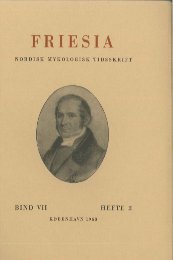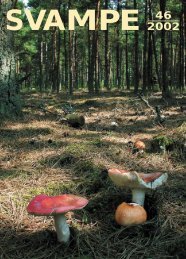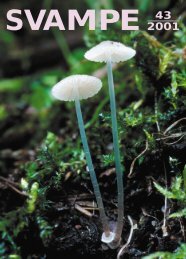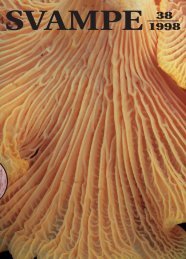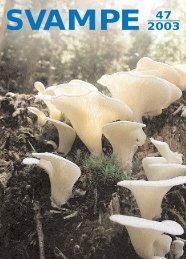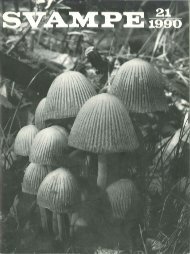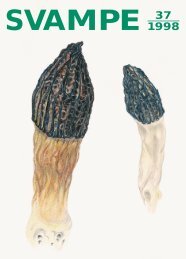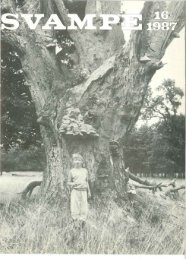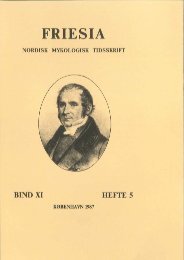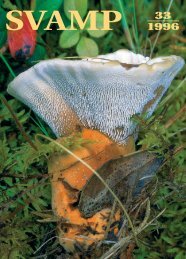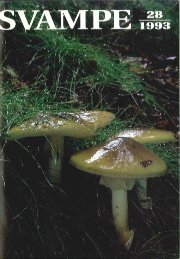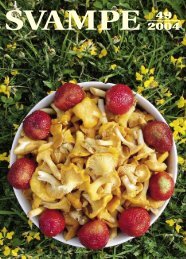Create successful ePaper yourself
Turn your PDF publications into a flip-book with our unique Google optimized e-Paper software.
- 174-<br />
Differs from the main species in the folIowing characters : P i l e u s<br />
with quite black, dull centre and the scales towards the margin<br />
blackish with a slightly brownish tinge on a grey ground, so that<br />
the colour and coating are exactly as in Tricholoma terreum (see<br />
L a n g e, Fl..Ag. Dan. I, t. 22 C, 1935). G i Il s conspicuously narrow<br />
and long white, even at the time when the ring becomes detached,<br />
later only pale flesh colour ("PaIe Grayish Vinaceous") before they<br />
become dark. S t e m turning yellow on pressure as in the main<br />
species, but not so readily, and not assuming a purplish brown<br />
colour in the yellow parts. F l e s h white, stem and cap shot in spots<br />
with lemon yellow when cut, but only slightly tinged with flesh<br />
colour in the upper part of the stem near the outer side. S c h af f e r<br />
r e a c t i o n negative. S p o re p o w d e r dingy brown ("Saccardos<br />
Umber"; L. o 6; S 132).<br />
S p o r e s obliquely ovate, 1-2-guttulate, (4-)5 X 31-'. B a s i d i a<br />
4-spored, clavate, 18-22 X 5.5-61-', with sterigmata 21-' long.<br />
M a r g i n a l c y s t i d i a balloon- to pear-shaped, 15-18 X 8-121-'<br />
in sterile border.<br />
Gregarious. Rare. September-October, 1943.<br />
Lolland: Saxkjøbing, in garden under fruit trees on bare soil.<br />
(Lindh. Hansen).<br />
Probably M a i r e's variety is identical. His diagnosis runs as<br />
follows: A typo differt squamis fusco-atris, lamellis angustissimis<br />
ex albo griseo-purpureis dein fusco-purpureis. P. xanthoderma v.<br />
grisea Pears. has a paler grey cap (according to water colours kindly<br />
sent by P e a r s o n) and a different form of spores. P. silvatica<br />
sensu Bres. is probably identic but has too large spores.<br />
The existence in England of P. xanthoderma v. grisea Pears.,<br />
which is actually more closely related to P. meleagris than to P.<br />
xanthoderma, together with the two Danish variants of P. meleaqris,<br />
shows that the latter is somewhat rich in forms. This' applies <br />
perhaps even in a higher degree still - to the closely related parallel<br />
species P. placomyces in the U.S.A., as A l e x a n d e r H. S m i t h<br />
has indeed partly indicated ("Ag. placomyces is rather variable").<br />
After perusing the somewhat copious literature concerning P. placo<br />
myces from that country the author thinks it safe to say that in the<br />
Western States (California, Oregon, Washington) the descriptions<br />
given of P . placomyces (see works by W. A. M u r r i Il, H o t s o n &<br />
S t u n t z, Z e Il e r) vary a good deal from those of the species in<br />
the Eastern States (ep. e. g. works by P e c k, K a u f f m a n n, V. O.



